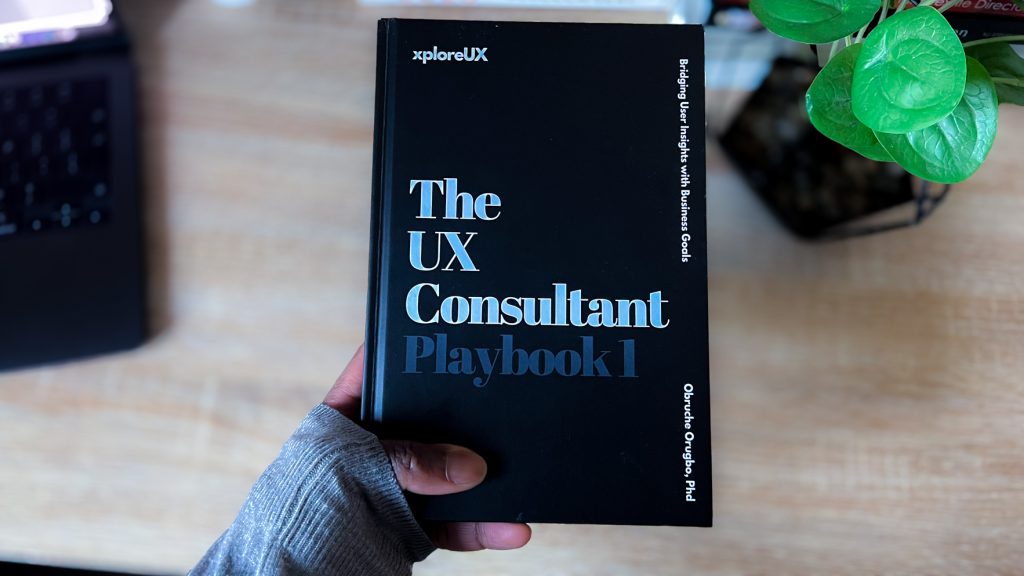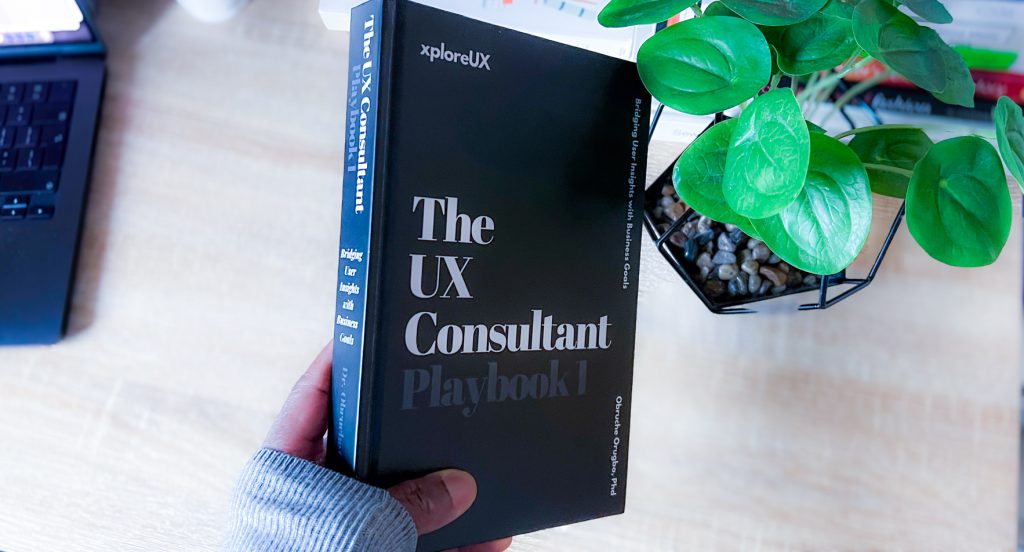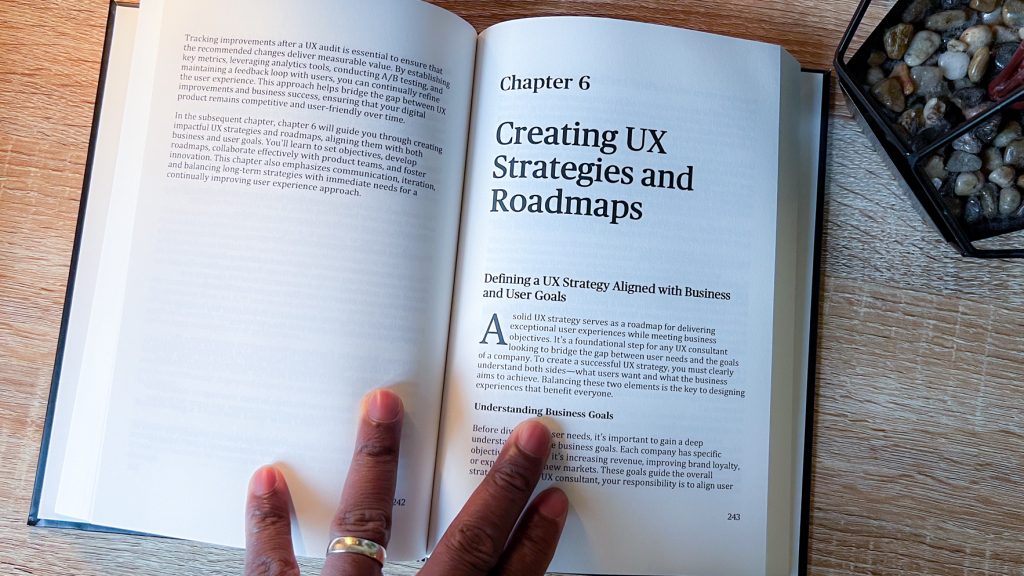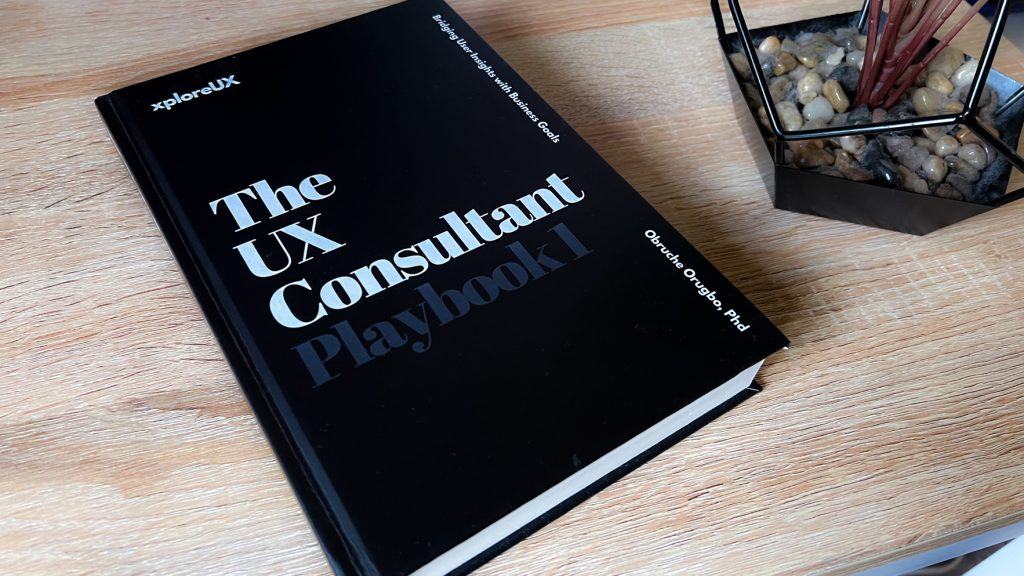The UX Consultant Playbook 1: Bridging User Insights with Business Goals is a definitive guide for professionals looking to transition from UX design to the more strategic role of UX consulting. With a wealth of practical advice, thoughtful insights, and actionable frameworks, the book demonstrates how user experience (UX) consultants can serve as a critical link between understanding users and driving business success.
Who Should Read This Book?
The UX Consultant Playbook 1 is a must-read for UX professionals looking to expand their skill set and transition into consulting roles. It’s also a valuable resource for business leaders, product managers, and designers who want to better understand the strategic impact of UX.
#
A Comprehensive Resource for Aspiring UX Consultants
The book opens with a compelling prologue, establishing the role of UX consultants as essential contributors to the success of modern digital products. While UX design focuses on creating user-friendly interfaces, Obruche highlights the consultant’s responsibility to ensure these designs align with broader business objectives. The introduction further clarifies the distinction between the tactical work of UX design and the strategic lens of UX consulting, setting the stage for the in-depth exploration to come.
Each chapter of the book builds on this foundation, covering topics ranging from stakeholder management to creating user journey maps. Obruche’s ability to combine theoretical concepts with real-world applications makes the content approachable for professionals at various stages of their careers.

A Deep Dive into UX Consulting Fundamentals
The first chapter, “The Fundamentals of UX Consulting,” provides a thorough overview of what it means to be a UX consultant. Obruche explains how UX consultants balance user needs with business goals, offering strategies for identifying pain points and recommending solutions. The chapter emphasizes the importance of understanding both the user’s perspective and the company’s objectives—a theme that resonates throughout the book.
Obruche demystifies UX consulting by breaking it into manageable concepts. For instance, he introduces frameworks for conducting audits, defining key performance indicators, and analyzing user feedback to inform strategic decisions. These insights make the role of a UX consultant less daunting for those transitioning from design-focused roles.
- The Innovator’s Dilemma by Clayton M. Christensen
- Book Review: Bigger Than This by Fabian Geyrhalter
- Book Review – The Information by Martin Amis
- Small Is Beautiful by E. F. Schumacher
- Never Split The Difference By Chris Voss
Bridging Research with Business Strategy
Chapter 2 focuses on the transition from UX research to UX consulting. Here, Obruche highlights the value of interpreting research findings within a business context. The chapter includes practical advice on synthesizing user data into actionable recommendations, a skill that is critical for UX consultants aiming to influence product strategies.
This section of the book also introduces tools and techniques for conducting research that goes beyond surface-level observations. By focusing on deeper user insights, Obruche ensures that readers understand how to create strategies that resonate with both users and stakeholders.
The Consultant’s Role in Product Strategy
Chapter 3 is a standout, exploring the UX consultant’s involvement in product strategy. Obruche illustrates how consultants can shape the direction of a product by aligning user needs with market opportunities. He provides concrete examples of how UX consultants can contribute during the product development lifecycle, from ideation to launch.
One of the book’s strengths is its emphasis on collaboration. Obruche offers advice on how UX consultants can work effectively with cross-functional teams, ensuring that all voices are heard while maintaining a focus on the user experience.

Practical Guidance on Stakeholder Management
Managing stakeholders is a recurring challenge for UX consultants, and Chapter 4 addresses this topic with clarity. Obruche provides a roadmap for navigating complex stakeholder dynamics, from building trust to resolving conflicts. His advice on tailoring communication styles to different audiences is particularly useful, as it highlights the importance of adaptability in the consulting process.
UX Audits and Heuristic Evaluations
In Chapter 5, Obruche takes a technical turn, delving into UX audits and heuristic evaluations. He provides step-by-step instructions for evaluating existing products, identifying usability issues, and proposing actionable improvements. This chapter is rich in detail, making it an invaluable resource for consultants tasked with improving underperforming products.
Obruche also stresses the importance of presenting audit findings in a way that resonates with stakeholders. By framing usability improvements as opportunities for increased revenue or customer retention, consultants can ensure their recommendations are taken seriously.
Building Strategies and Roadmaps
Chapter 6 focuses on creating UX strategies and roadmaps. Obruche guides readers through the process of translating research insights into long-term plans that align with business goals. His emphasis on prioritization and adaptability ensures that these roadmaps remain relevant as business needs evolve.
This chapter is particularly helpful for consultants looking to establish themselves as strategic partners within their organizations. By demonstrating how UX can drive measurable outcomes, consultants can secure buy-in from stakeholders and solidify their role in decision-making processes.
User Journey Mapping and Experience Blueprinting
User journey mapping is one of the most effective tools in a UX consultant’s toolkit, and Chapter 7 provides a masterclass on this topic. Obruche explains how to create detailed maps that capture the user’s experience, identify pain points, and highlight opportunities for improvement.
The chapter also introduces experience blueprinting, a technique that goes beyond individual touchpoints to examine the broader context of the user’s journey. Obruche’s practical examples make these concepts accessible, even for those new to the field.
Facilitating Workshops and Co-Creation Sessions
Chapter 8 emphasizes the importance of collaboration in UX consulting. Obruche offers tips for facilitating workshops and co-creation sessions, ensuring that all participants feel heard and valued. He also provides advice on overcoming common challenges, such as managing dominant personalities and maintaining focus during brainstorming sessions.
This chapter highlights the consultant’s role as a facilitator, bridging gaps between teams and fostering a shared understanding of user needs.

Key Takeaways from The UX Consultant Playbook 1
Obruche’s The UX Consultant Playbook 1 is a rich resource that provides practical insights into the evolving role of UX consultants. It highlights the strategic importance of bridging user insights with business objectives and equips readers with actionable frameworks for driving impactful decisions.
One of the main takeaways is the distinction between UX design and UX consulting. While UX design focuses on creating user-friendly interfaces, UX consulting takes a broader approach by aligning user needs with business goals. This strategic perspective allows consultants to influence decisions beyond aesthetics and functionality, ensuring that user experience becomes a core component of a company’s strategy.
The book emphasizes the importance of effective stakeholder management. Obruche provides guidance on building trust, communicating value, and resolving conflicts with stakeholders. These skills are crucial for consultants, as they often act as intermediaries between design teams and business leaders. Tailoring communication to different audiences and demonstrating the tangible benefits of UX are recurring themes throughout the book.
Another significant takeaway is the role of research in consulting. Obruche explains how to synthesize user data into actionable recommendations that address pain points and drive measurable improvements. The ability to translate complex findings into clear, strategic insights is a skill that sets UX consultants apart.
The book also provides detailed guidance on conducting UX audits and heuristic evaluations. These methods help consultants identify usability issues and recommend improvements that align with both user expectations and business priorities. Obruche’s step-by-step approach ensures that readers can apply these techniques effectively.
Creating UX strategies and roadmaps is another critical aspect covered in the book. Obruche offers practical advice on prioritizing initiatives and maintaining flexibility as business needs evolve. This section highlights the importance of long-term planning in ensuring that UX efforts deliver sustained value.
Finally, the book explores collaborative techniques like user journey mapping, experience blueprinting, and workshop facilitation. These tools enable consultants to foster alignment among teams and create a shared vision for improving user experiences.
Overall, The UX Consultant Playbook 1 equips readers with the skills and knowledge to excel in UX consulting. It is a valuable guide for anyone looking to make user experience a driving force in achieving business success.
Obruche has created a comprehensive guide that demystifies the role of a UX consultant. By bridging the gap between user insights and business goals, the book provides readers with the tools they need to drive meaningful change in their organizations. Whether you’re new to UX or a seasoned professional, The UX Consultant Playbook 1 is an essential addition to your library.

Final Thoughts
The conclusion ties together the book’s key themes, reinforcing the idea that UX consulting is both an art and a science. Obruche encourages readers to embrace the complexity of the role, emphasizing the rewards of helping organizations deliver meaningful experiences to their users.
What Sets This Book Apart
Obruche’s writing is clear, concise, and free from jargon, making complex concepts easy to understand. His use of real-world examples and case studies adds depth to the material, while his practical advice ensures that readers can apply what they’ve learned immediately.
The book’s structure is another strength. Each chapter builds logically on the last, guiding readers through the nuances of UX consulting without overwhelming them. The inclusion of tools, frameworks, and actionable tips makes this a valuable resource for both new and experienced consultants.
